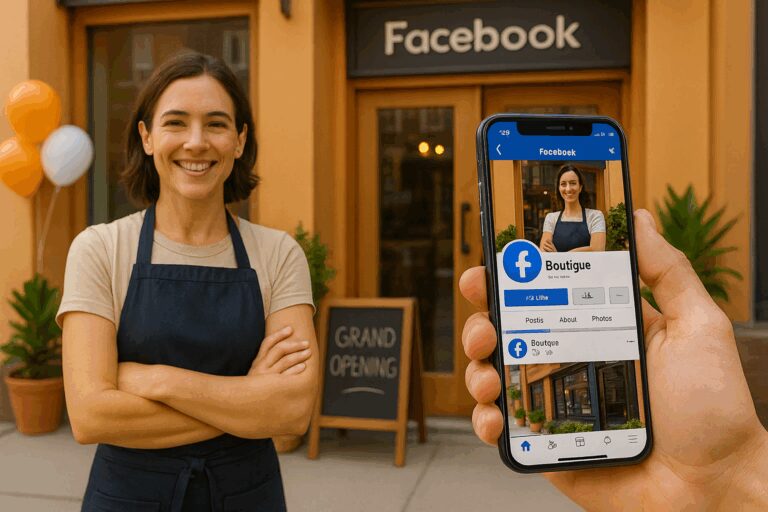Social media is one of the fastest, lowest-cost ways for startups to build visibility and connect with their audience. Unlike traditional advertising, it’s not just about broadcasting—it’s about conversation. The right social media presence helps you build trust, demonstrate your expertise, showcase your personality, and create a community around your business.
When used strategically, social media can:
- Put your business in front of people where they already spend time.
- Drive traffic to your website or physical location.
- Give you direct feedback from customers.
- Amplify your reputation through shares and reviews.
Setting Up Branded Company Pages
Your first step is to claim your real estate. Set up branded company pages on the major platforms so you control your name, look professional, and can be found in searches. Even if you don’t plan to post regularly on all of them, it’s smart to secure your presence.
- Facebook: Still the most widely used platform, especially for local businesses. Strong for events, community updates, and customer interaction.
- Instagram: Visual storytelling. Perfect for showcasing photos and short videos—restaurants, boutiques, contractors, and creative businesses thrive here.
- LinkedIn: Best for professional services, B2B, and networking. Great for credibility and thought leadership.
- TikTok: Short, engaging videos for younger audiences. Works well for brands with personality and creativity to share.
- X (formerly Twitter): Real-time updates and quick interactions. More relevant if your business involves news, events, or industry thought leadership.
- Threads: Meta’s alternative to X. Early days, but worth watching—especially if you’re already active on Instagram.
- Pinterest: Strong for lifestyle, retail, food, and DIY businesses. Great for long-term discovery (pins can drive traffic months later).
For most startups, it’s best to choose one or two primary platforms based on your audience and the type of content you can produce consistently. Use the others as supporting channels—either to claim your brand name, repost key content, or provide credibility.
Developing Content That Connects
The number one rule of social media content: don’t only sell, tell a story. People come to these platforms to be informed, entertained, and inspired—not to be bombarded with ads.
Here are some best practices:
- Mix content types:
- Behind-the-scenes photos (e.g., a contractor showing a job in progress).
- Tips or how-to’s (e.g., a bakery posting “3 secrets to keeping bread fresh”).
- Customer highlights (with permission, share testimonials or success stories).
- Seasonal content (e.g., a landscaping company showing fall clean-up tips).
- Special offers or promotions (but keep these to 1 in every 4-5 posts).
- Post consistently: Aim for at least 2-3 posts per week on your primary platform. Quality beats quantity—better to have a steady presence than to flood and then go silent.
- Use visuals: Photos and videos almost always outperform text alone. Even a smartphone photo of your team at work feels more authentic than stock photos.
- Keep captions conversational: Ask questions, share short insights, or invite opinions. Engagement grows when you sound like a person, not a press release.
Planning and Scheduling Your Posts
One of the biggest challenges for startups is staying consistent. That’s where planning and scheduling tools come in. Instead of scrambling to post in real time, you can batch your content and let software do the heavy lifting.
A good practice is to create a content calendar—plan what you’ll post, when you’ll post it, and on which platform. This helps you stay organized, align posts with promotions or events, and avoid long gaps in activity.
Two affordable scheduling tools to consider are:
- Buffer: A low-cost, easy-to-use option that lets you schedule posts across multiple platforms. Buffer also offers basic analytics so you can see which posts perform best.
- Later: Another simple tool with a visual content calendar, great for Instagram-heavy strategies. Later also provides hashtag suggestions and media management features.
Even if you only plan a week ahead, scheduling tools free up your time and keep your posting consistent—two keys to building trust with your audience.
Monitoring and Engaging with Your Audience
Social media is not a one-way street. Once your posts are live, your job is only half done.
- Reply to comments quickly: Even a simple “Thanks!” shows you’re paying attention. If someone asks a question, answer clearly and promptly.
- Invite likes to follow your page: If someone reacts to your post but isn’t following you, invite them to connect. It’s an easy way to grow your base.
- Acknowledge shares: When people share your post, like or comment on their share. It reinforces the relationship.
Engagement builds trust and signals to the platforms’ algorithms that your content is worth showing to more people.
Supporting Others to Raise Visibility
Engagement shouldn’t just go one way. Following other local businesses, nonprofits, and community pages can raise your visibility and help you build goodwill.
Like, comment, and share posts from:
- Neighboring businesses.
- Industry peers.
- Community events or nonprofits you support.
For example, a new coffee shop could share a nearby bookstore’s author signing event. A contractor might comment on a local realtor’s post about new listings. This shows you’re invested in the community and builds reciprocal support.
Recap and Practical Next Steps
Social media can feel overwhelming, but it doesn’t have to be. Start with a simple plan and build from there.
Next steps for your startup:
- Claim and set up branded company pages on all major platforms.
- Choose 1–2 primary platforms where you’ll post regularly.
- Develop a content plan with 2–3 posts per week mixing behind-the-scenes, tips, customer highlights, and promotions.
- Monitor for comments, likes, and shares—reply, invite, and thank.
- Follow and engage with other local businesses and community pages.
Consistency and authenticity will matter more than perfection.
Frequently Asked Questions
1. Do I need to be on every social media platform?
No. Claim your name on all of them, but focus your time on one or two that best fit your audience and content style.
2. How often should I post?
Start with 2–3 posts per week. If you can sustain more without sacrificing quality, great—but consistency is more important than volume.
3. What if I don’t have good photos or videos?
Use your phone. Authentic, behind-the-scenes content often performs better than polished, stock images.
4. How do I know what kind of content my audience wants?
Test different formats—tips, photos, videos, polls. See what gets the most engagement and double down on that.
5. Should I pay for ads right away?
Not necessarily. Focus first on building organic content and engagement. Paid ads can come later once you have a clearer sense of your audience.
6. How do I handle negative comments?
Respond politely and professionally. Don’t ignore or delete unless it’s offensive or spam. A calm reply can turn criticism into respect.
7. Can I post the same content on multiple platforms?
Yes, but adapt the format. A LinkedIn post might need a professional tone, while Instagram works better with visuals and hashtags.
8. How long will it take to see results?
Expect at least 3–6 months of consistent effort before you see steady traction. Social media growth compounds over time.
9. Do hashtags still matter?
Yes, but don’t overdo it. A few well-chosen hashtags can help discovery, especially on Instagram, LinkedIn, and TikTok.
10. What if I don’t have time to manage social media?
Consider scheduling tools (like Buffer or Later) to plan posts ahead of time. Or delegate to a team member who can own it. The key is consistency.



